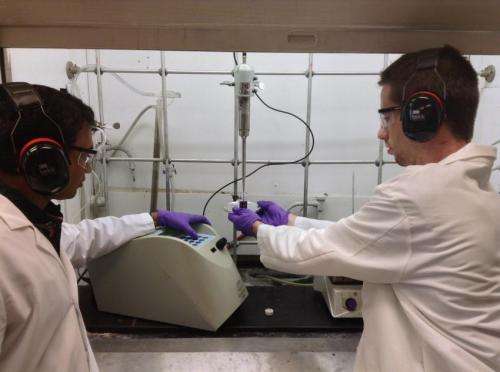Eco-friendly 'pre-fab nanoparticles' could revolutionize nano manufacturing

A team of materials chemists, polymer scientists, device physicists and others at the University of Massachusetts Amherst today report a breakthrough technique for controlling molecular assembly of nanoparticles over multiple length scales that should allow faster, cheaper, more ecologically friendly manufacture of organic photovoltaics and other electronic devices. Details are in the current issue of Nano Letters.
Lead investigator, chemist Dhandapani Venkataraman, points out that the new techniques successfully address two major goals for device manufacture: controlling molecular assembly and avoiding toxic solvents like chlorobenzene. "Now we have a rational way of controlling this assembly in a water-based system," he says. "It's a completely new way to look at problems. With this technique we can force it into the exact structure that you want."
Materials chemist Paul Lahti, co-director with Thomas Russell of UMass Amherst's Energy Frontiers Research Center (EFRC) supported by the U.S. Department of Energy, says, "One of the big implications of this work is that it goes well beyond organic photovoltaics or solar cells, where this advance is being applied right now. Looking at the bigger picture, this technique offers a very promising, flexible and ecologically friendly new approach to assembling materials to make device structures."
Lahti likens the UMass Amherst team's advance in materials science to the kind of benefits the construction industry saw with prefabricated building units. "This strategy is right along that general philosophical line," he says. "Our group discovered a way to use sphere packing to get all sorts of materials to behave themselves in a water solution before they are sprayed onto surfaces in thin layers and assembled into a module. We are pre-assembling some basic building blocks with a few predictable characteristics, which are then available to build your complex device."
"Somebody still has to hook it up and fit it out the way they want," Lahti adds. "It's not finished, but many parts are pre-assembled. And you can order characteristics that you need, for example, a certain electron flow direction or strength. All the modules can be tuned to have the ability to provide electron availability in a certain way. The availability can be adjusted, and we've shown that it works."
The new method should reduce the time nano manufacturing firms spend in trial-and-error searches for materials to make electronic devices such as solar cells, organic transistors and organic light-emitting diodes. "The old way can take years," Lahti says.
"Another of our main objectives is to make something that can be scaled up from nano- to mesoscale, and our method does that. It is also much more ecologically friendly because we use water instead of dangerous solvents in the process," he adds.
For photovoltaics, Venkataraman points out, "The next thing is to make devices with other polymers coming along, to increase power conversion efficiency and to make them on flexible substrates. In this paper we worked on glass, but we want to translate to flexible materials and produce roll-to-roll manufactured materials with water. We expect to actually get much greater efficiency." He suggests that reaching 5 percent power conversion efficiency would justify the investment for making small, flexible solar panels to power devices such as smart phones.
If the average smart phone uses 5 watts of power and all 307 million United States users switched from batteries to flexible solar, it could save more than 1500 megawatts per year. "That's nearly the output of a nuclear power station," Venkataraman says, "and it's more dramatic when you consider that coal-fired power plants generate 1 megawatt and release 2,250 lbs. of carbon dioxide. So if a fraction of the 6.6 billion mobile phone users globally changed to solar, it would reduce our carbon footprint a lot."
Doctoral student and first author Tim Gehan says that organic solar cells made in this way can be semi-transparent, as well, "so you could replace tinted windows in a skyscraper and have them all producing electricity during the day when it's needed. And processing is much cheaper and cleaner with our cells than in traditional methods."
Venkataraman credits organic materials chemist Gehan, with postdoctoral fellow and device physicist Monojit Bag, with making "crucial observations" and using "persistent detective work" to get past various roadblocks in the experiments. "These two were outstanding in helping this story move ahead," he notes. For their part, Gehan and Bag say they got critical help from the Amherst Fire Department, which loaned them an infrared camera to pinpoint some problem hot spots on a device.
It was Bag who put similar sized and charged nanoparticles together to form a building block, then used an artist's airbrush to spray layers of electrical circuits atop each other to create a solar-powered device. He says, "Here we pre-formed structures at nanoscale so they will form a known structure assembled at the meso scale, from which you can make a device. Before, you just hoped your two components in solution would form the right mesostructure, but with this technique we can direct it to that end."
More information: Nano Letters, pubs.acs.org/doi/pdf/10.1021/nl502209s
Journal information: Nano Letters
Provided by University of Massachusetts Amherst




















